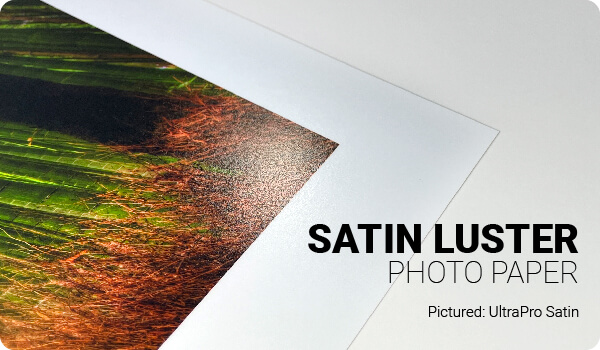Satin Paper vs Matte: Differences & When To Choose Each One

In the ever-expanding and evolving realm of photography, various mediums are available for showcasing captured moments, with satin and matte finishes being two popular choices for photo prints.
Satin and matte finishes each possess distinctive characteristics and benefits, presenting both emerging and experienced photographers with a sometimes-challenging decision. This article explores the differences between satin photo paper and matte photo paper, providing insights to guide your selection.
What is Satin Photo Paper?
Satin paper exhibits a medium sheen, positioning itself between glossy and matte finishes. This paper is known for its soft, lustrous quality, and lightly textured surface.
What is Matte Photo Paper?
Matte photo papers, in contrast, present a non-glossy, flat appearance. Its non-reflective finish makes it suitable for photos intended for viewing under bright light and for images where you want the viewer to see maximum detail.
Differences Between Satin and Matte Photo Papers
The difference between satin and matte photo papers can be categorized into three areas: texture and feel, reflection and glare, and color vibrancy and depth.
Texture and Feel of Satin vs Matte
With a subtle sheen, satin has a light texture, known in the photography industry as the “E-Surface”. That said, the surface is fairly smooth to the touch.
The matte finish, alternatively, is very smooth in terms of appearance and touch. It is totally non-reflective.
Reflection and Glare of Satin vs Matte
Satin papers have a semi-gloss finish that reflects some light, albeit less than its glossy counterparts.
With its non-reflective nature, matte effectively reduces glare, making it ideal for brightly lit environments.
Color Vibrancy and Depth of Satin vs Matte
Satin amplifies color vibrancy, lending images a lively quality with deeper blacks and heightened contrast compared to matte.
Offering softer, muted colors, matte provides a natural appearance ideal for black-and-white photos or those with subtle tones.
When to Choose Satin Paper or Matte Paper?
Satin Photo Paper Is Ideal For:
Portraits: Satin’s subtle shine enhances details and depth in skin tones.
Landscapes: The finish’s color vibrancy makes nature photographs stand out.
Mixed Lighting Photos: Satin adeptly manages contrasts between dark and light elements.
Matte Photo Paper Is Ideal For:
Artistic Prints: The muted finish of matte complements artistic photographs.
Bright Space Displays: With no light reflection, matte is perfect for images displayed in well-lit areas.
Scrapbooking: The tactile texture of matte adds a sensory layer to scrapbook pages.
Conclusion
Both satin and matte photo paper have their unique qualities and potential applications. Your choice between them should be influenced by the intent of the photo, the viewing environment, and personal aesthetic preferences. Always remember, the best paper finish is the one that elevates your photography and resonates with your vision.
Original Publication Date: June 01, 2023
Article Last updated: April 29, 2024
Related Posts and Information
Categories
About Photographers
Announcements
Back to Basics
Books and Videos
Cards and Calendars
Commentary
Contests
Displaying Images
Editing for Print
Events
Favorite Photo Locations
Featured Software
Free Stuff
Handy Hardware
How-To-Do-It
Imaging
Inks and Papers
Marketing Images
Monitors
Odds and Ends
Photo Gear and Services
Photo History
Photography
Printer Reviews
Printing
Printing Project Ideas
Red River Paper
Red River Paper Pro
RRP Products
Scanners and Scanning
Success on Paper
Techniques
Techniques
Tips and Tricks
Webinars
Words from the Web
Workshops and Exhibits
all
Archives
January, 2025
December, 2024
November, 2024
October, 2024
September, 2024
August, 2024
July, 2024
June, 2024
May, 2024
more archive dates
archive article list




